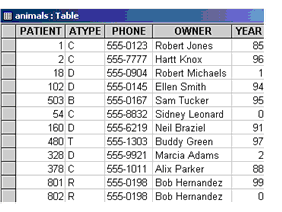NUMERIC directive
The NUMERIC directive allows you to treat a data item as an unsigned integer when it is declared as alphanumeric. You might use this when the data stored in the item is always numeric.
Syntax
$XFD NUMERIC
or
*(( XFD NUMERIC ))
Example
The PATIENT-ID field (now appearing in the database table as the PATIENT column) is defined in the source code as being a text field. Since this field will always contain a number, you may want to define it in the database table as numeric. (Note the use of two directives for the same data item here.)
FILE SECTION.
FD jr-file.
$XFD COMMENT This sample file demonstrates directives.
01 jr-record.
03 animal-info.
$XFD NAME=PATIENT, NUMERIC
05 patient-id pic x(5).
05 atype pic x.
05 ctype redefines atype pic x.
05 dtype redefines atype pic x.
05 otype redefines atype pic x.
03 owner-info.
05 phone pic x(8).
05 owner pic x(30).
03 financial.
05 acct_no.
10 year pic x(2).
10 seq_no pic x(4).
$XFD DATE=YYYYMMDD, USE GROUP
05 last_visit.
10 yyyy pic 9(4).
10 mm pic 9(2).
10 dd pic 9(2).
$XFD HIDDEN
05 fee pic s9(5)v99.
The following table is the result, and, in the database, PATIENT is now of type NUMBER.
